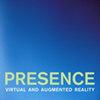Magnetic Tracker Calibration for Improved Augmented Reality Registration
IF 0.7
4区 计算机科学
Q4 COMPUTER SCIENCE, CYBERNETICS
引用次数: 104
Abstract
We apply a look-up table technique to calibrate both position and orientation readings from a magnetic tracker for use in virtual environments within a defined working volume. In a test volume of 2.4 cubic meters, the method reduced the tracker's average position error by 79% and its average orientation error by 40%. We test the correction table against the tracker's performance outdoors (a metal-poor environment) and show that readings taken in our lab and corrected by our method exhibit less error than uncorrected readings taken outdoors. We demonstrate that such reduction in position error visibly improves registration in an augmented reality system, whereas the (lesser) reduction in orientation error does not visibly improve registration. We show that the model we used for the orientation error function was incorrect, preventing our method from achieving better correction of orientation error, We discuss future directions for correction of orientation error.改进的增强现实注册磁跟踪器校准
我们应用查找表技术来校准磁跟踪器的位置和方向读数,以便在定义的工作体积内的虚拟环境中使用。在2.4立方米的测试体积中,该方法将跟踪器的平均位置误差降低了79%,平均方向误差降低了40%。我们根据跟踪器在户外(金属贫乏的环境)的性能测试了校正表,并表明在我们实验室中采用我们的方法校正的读数比在户外未校正的读数显示出更小的误差。我们证明了这种位置误差的减少明显改善了增强现实系统中的配准,而(较小的)方向误差的减少并没有明显改善配准。结果表明,我们所使用的定向误差函数模型是不正确的,这使得我们的方法无法实现更好的定向误差校正。
本文章由计算机程序翻译,如有差异,请以英文原文为准。
求助全文
约1分钟内获得全文
求助全文
来源期刊
CiteScore
2.20
自引率
0.00%
发文量
8
审稿时长
>12 weeks

 求助内容:
求助内容: 应助结果提醒方式:
应助结果提醒方式:


